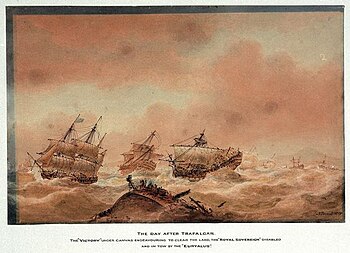HMS Royal Sovereign (1786)

The day after Trafalgar, the Victory under canvas endeavouring to clear the land, the Royal Sovereign disabled and in tow by the Euryalus, in the collection of the National Maritime Museum; Nicholas Pocock; 19th century.
|
|
| History | |
|---|---|
|
|
|
| Name: | HMS Royal Sovereign |
| Ordered: | 3 February 1786 |
| Builder: | Plymouth Dockyard |
| Laid down: | 7 January 1774 |
| Launched: | 11 September 1786 |
| Renamed: | HMS Captain, 17 August 1825 |
| Honours and awards: |
Participated in: |
| Fate: | Broken up, 1841 |
| Notes: | Harbour service from 1826 |
| General characteristics | |
| Class and type: | 100-gun first rate ship of the line |
| Tons burthen: | 2175 (bm) |
| Length: | 183 ft 10 1⁄2 in (56.0 m) (gundeck) |
| Beam: | 52 ft 1 in (15.88 m) |
| Depth of hold: | 22 ft 2 1⁄2 in (6.8 m) |
| Propulsion: | Sails |
| Sail plan: | Full rigged ship |
| Armament: | |
HMS Royal Sovereign was a 100-gun first rate ship of the line of the Royal Navy, which served as the flagship of Admiral Collingwood at the Battle of Trafalgar. She was the third of seven Royal Navy ships to bear the name. Designed by Sir Edward Hunt, she was launched at Plymouth Dockyard on 11 September 1786, at a cost of £67,458, and was the only ship built to her draught. She was known by her crew as the "West Country Wagon" due to her poor manoeuvrability and speed.
Royal Sovereign was part of Admiral Howe's fleet at the Glorious First of June, where she suffered 14 killed and 41 wounded.
On 16 June 1795, as the flagship of Vice-Admiral William Cornwallis, she was involved in the celebrated episode known as 'Cornwallis' Retreat'.
The first ship of the fleet in action at Trafalgar on 21 October 1805, she led one column of warships; Nelson's Victory led the other. Due to the re-coppering of her hull prior to her arrival off Cádiz, Royal Sovereign was a considerably better sailer in the light winds present that day than other vessels, and pulled well ahead of the rest of the fleet. As she cut the enemy line alone and engaged the Spanish three decker Santa Ana, Nelson pointed to her and said, 'See how that noble fellow Collingwood carries his ship into action!' At approximately the same moment, Collingwood remarked to his captain, Edward Rotheram, 'What would Nelson give to be here?'
...
Wikipedia
